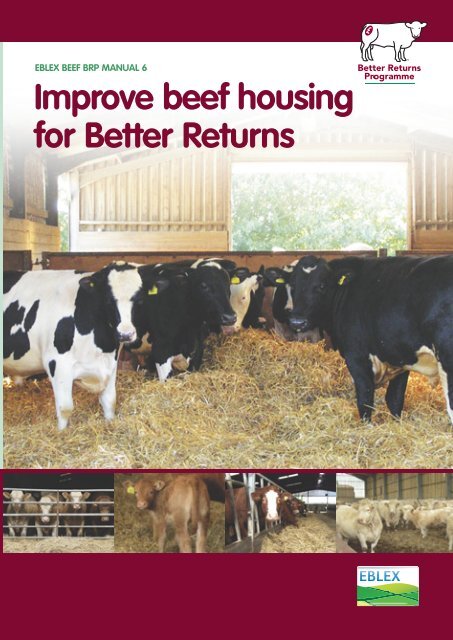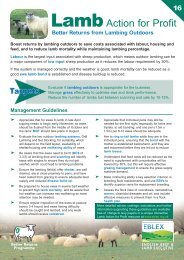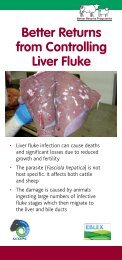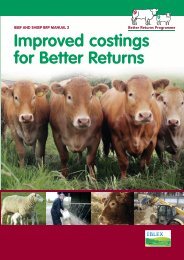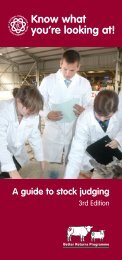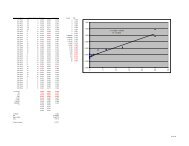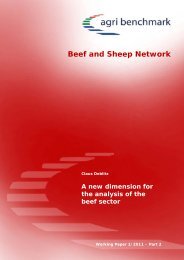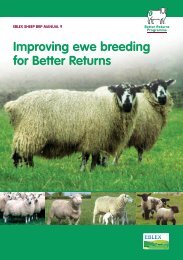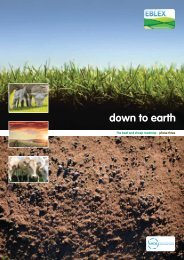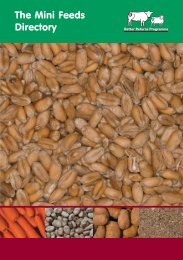Improve beef housing for Better Returns - Eblex
Improve beef housing for Better Returns - Eblex
Improve beef housing for Better Returns - Eblex
You also want an ePaper? Increase the reach of your titles
YUMPU automatically turns print PDFs into web optimized ePapers that Google loves.
EBLEX BEEF BRP MANUAL 6<br />
<strong>Improve</strong> <strong>beef</strong> <strong>housing</strong><br />
<strong>for</strong> <strong>Better</strong> <strong>Returns</strong>
The in<strong>for</strong>mation in this booklet was compiled by Dr Phil Hadley<br />
EBLEX, based on in<strong>for</strong>mation supplied by Dr Mike Kelly.<br />
BRP is grateful to all those who have commented and contributed<br />
to this production.<br />
Edited: Geoff Dodgson, Chamberlain<br />
Illustrations: Tebbit Design<br />
EBLEX Beef <strong>Better</strong> <strong>Returns</strong> Programme<br />
has funded the writing and<br />
publication of this booklet. While the<br />
authors have worked on the best<br />
in<strong>for</strong>mation available to them, neither<br />
the EBLEX Beef <strong>Better</strong> <strong>Returns</strong><br />
Programme, nor the authors shall in<br />
any event be liable <strong>for</strong> any loss, damage<br />
or injury howsoever suffered directly or<br />
indirectly in relation to the booklet or<br />
the in<strong>for</strong>mation on which it is based.<br />
Reference herein to trade names and<br />
proprietary products and services<br />
without stating that they are protected<br />
does not imply that they may be<br />
regarded as unprotected and thus free<br />
<strong>for</strong> general use. No endorsement of<br />
named products or services is intended<br />
nor any criticism implied of other<br />
alternative but unnamed products.<br />
For more in<strong>for</strong>mation contact:<br />
<strong>Better</strong> <strong>Returns</strong> Programme<br />
EBLEX Ltd<br />
Graphic House<br />
Ferrars Road<br />
Huntingdon<br />
PE29 3EE<br />
Tel: 0870 241 8829<br />
Fax: 0871 433 6205<br />
Email: brp@eblex.org.uk<br />
www.eblex.org.uk/betterreturns<br />
© 2008 EBLEX Ltd
Contents<br />
2 Looking at the big picture<br />
4 How good are your<br />
buildings?<br />
6 Measuring up your building<br />
8 Ventilation<br />
9 Testing your ventilation<br />
10 Diseases affecting housed<br />
stock<br />
12 Spot the faults<br />
13 Housing checklist<br />
It is all too easy to take stockyards and<br />
buildings <strong>for</strong> granted. In fact, they are an<br />
important part in the whole <strong>beef</strong> production<br />
system and influence profitability.<br />
Well-planned <strong>housing</strong> will make stockmanship<br />
easier, encourage optimum livestock<br />
production and play a very important part<br />
in ensuring good disease management. All<br />
this adds up to improvements on the<br />
bottom line.<br />
In recent years, our understanding of best<br />
practice and design in livestock buildings has<br />
increased significantly. This booklet, the latest<br />
in our series of Beef <strong>Better</strong> <strong>Returns</strong> manuals,<br />
brings together the latest thinking and aims<br />
to prompt you to take a fresh look at your<br />
own set up.<br />
Stock <strong>housing</strong> represents a significant<br />
investment. If you are in a position to invest<br />
in new buildings, then this booklet will give<br />
you some useful tips as you plan construction.<br />
However, you do not need to replace<br />
buildings. Many older buildings are sound,<br />
but with some thought can be significantly<br />
improved in terms of layout and, critically,<br />
ventilation. Investing some time in reviewing<br />
your <strong>housing</strong> and some money and ef<strong>for</strong>t<br />
in renovation will also<br />
pay dividends.<br />
John Cross<br />
Chairman<br />
EBLEX Ltd<br />
1
Look at the big picture<br />
Housing brings stock together in a<br />
relatively confined environment<br />
and possibly in new social groups.<br />
There<strong>for</strong>e, conditions must be right<br />
to minimise undue stress on<br />
livestock or stockpersons.<br />
Take a fresh look at your buildings, or ask<br />
someone else to do so. It may well be that there<br />
are simple ways to make big improvements.<br />
Ensure lighting is adequate<br />
to inspect stock at all times.<br />
Machinery access <strong>for</strong> feeding<br />
and cleaning out will make a<br />
big difference to time<br />
consuming activities.<br />
On many farms there is scope to make<br />
changes to stock buildings and layout<br />
that will deliver big benefits to efficiency<br />
of labour, use of feed and animal<br />
per<strong>for</strong>mance.<br />
Building improvement does not<br />
necessarily require large capital<br />
investment or major reorganisation.<br />
What it needs is some thought and a<br />
willingness to try out new approaches.<br />
Visit successful units and see how<br />
others are making good use of their<br />
buildings.<br />
Drainage avoids build up of<br />
stagnant water and leaving<br />
animals on damp bedding.<br />
2
Ventilation is perhaps the<br />
most critical issue to reduce<br />
the risk of disease build-up.<br />
Water access must be<br />
adequate to ensure all stock<br />
can drink without bullying.<br />
Staff access must enable<br />
easy access without climbing<br />
fencing or opening<br />
cumbersome gates.<br />
Pen sizes should be<br />
adjusted to reduce stress<br />
and make it easier to<br />
manage matched groups of<br />
animals <strong>for</strong> optimum<br />
per<strong>for</strong>mance.<br />
Windproof against the<br />
prevailing wind.<br />
Feeding areas can be improved<br />
to reduce both animal stress<br />
through bullying and feed waste.<br />
Joined up layout makes<br />
movement of animals simple<br />
and stress free.<br />
3
How good are your buildings?<br />
The following checklist will help you look afresh at your buildings. Be brutally honest!<br />
Essential provisions Yes No<br />
Floor space<br />
Is there sufficient floor space to meet the minimum<br />
requirements of welfare codes or assurance schemes?<br />
Ideally, you should have at least 20% more than this.<br />
Floors and bedding<br />
Is bedding adequate to keep floors dry throughout<br />
the winter?<br />
Group size<br />
Are animals in manageable sized groups?<br />
Steers and heifers should be less than 40 animals/group.<br />
Bulls should be less than 20 animals/group.<br />
Grouping<br />
Are groups well-matched in terms of sex and size?<br />
Feeding<br />
Is there ready access to food, under cover, which is not<br />
wasted through poor trough or barrier design?<br />
Is access <strong>for</strong> birds and rodents minimised?<br />
Water<br />
Can all stock access unlimited quantities of clean<br />
drinking water at all times?<br />
For more in<strong>for</strong>mation on livestock <strong>housing</strong> visit the Defra website at:<br />
www.defra.gov.uk/animalh/welfare/farmed/cattle/booklets/cattcode.pdf<br />
4
Essential provisions Yes No<br />
Ventilation<br />
Is ventilation generous throughout your buildings?<br />
Look <strong>for</strong> good inlets to bring in fresh air and good<br />
outlets <strong>for</strong> stale air.<br />
Air space<br />
Does the space exceed the minimum welfare<br />
requirements?<br />
Lighting<br />
Is the current lighting sufficient to ensure all cattle<br />
can be inspected day or night?<br />
Handling facilities<br />
Are these adequate <strong>for</strong> safe and easy handling of all<br />
categories of stock you manage? See EBLEX Beef BRP<br />
Manual 3: Improving cattle handling <strong>for</strong> <strong>Better</strong> <strong>Returns</strong><br />
Equipment condition<br />
Do you regularly inspect and maintain barriers, gates,<br />
pens, floors, etc to ensure stress free handling and avoid<br />
injury to staff or stock?<br />
Capacity<br />
Do you have sufficient capacity to meet routine needs<br />
such as quarantine and to deal with crises, such as<br />
infections?<br />
Above all, are you running your <strong>housing</strong>? Or, is your <strong>housing</strong> running you?<br />
The Rural and Industrial Design and Building Association can provide advice on good design<br />
www.ridba.org.uk<br />
5
Measuring up your building<br />
What is the volume of the building?<br />
It is important to measure any livestock building to ensure that floor space and air volume are<br />
adequate <strong>for</strong> the number of animals you intend to house.<br />
Assessing your roof volume<br />
D= height<br />
C = height to eaves<br />
Roof volume = roof height (D) x floor area<br />
Assessing your main building volume<br />
Main building volume = height (C) x floor<br />
area (A x B)<br />
A = length<br />
B = width<br />
Total building volume = main building<br />
volume + roof volume<br />
Assessing your floor area<br />
Floor area = length (A) x width (B)<br />
of the building<br />
(This will give the ground area in square<br />
feet or metres, depending on whether you<br />
prefer to measure in metres or feet.)<br />
Understanding the volumes of air in your<br />
buildings is critical to meeting welfare<br />
standards and assessing the ventilation<br />
needs of the building.<br />
NOTE: Estimates are perfectly adequate, do<br />
NOT attempt to climb on roof when measuring<br />
up, or exceed safe working heights on ladders<br />
or plat<strong>for</strong>ms.<br />
6
Height is important in providing adequate volumes of air. Ideally, the height of the eaves in buildings<br />
<strong>for</strong> <strong>beef</strong> animals should be at least 4.5m high. This also ensures good access <strong>for</strong> modern farm<br />
machinery.<br />
Also, check that the ridge opening is adequate <strong>for</strong> the width of your building. Ensure the inlet<br />
opening below the eaves is at least four times more than the ridge outlet space to ensure a steady<br />
supply of fresh air.<br />
Temperature within a livestock building should never be controlled by restricting ventilation – either<br />
inlets or outlets.<br />
Is your building adequate?<br />
There are rules of thumb <strong>for</strong> both air space and ventilation area:<br />
Calf up to 90kg<br />
Air space<br />
Ventilation ridge opening<br />
(cu metres)<br />
(sq m/100 animals)<br />
Guideline My space Guideline My opening<br />
10 5<br />
Young animal 90 –150 kg<br />
13 8<br />
Larger animal 150kg +<br />
15 8<br />
7
Ventilation<br />
Correct and adequate ventilation is one of the most important features of any livestock building to<br />
ensure efficient production and, vitally, minimise health disorders.<br />
Most UK farm buildings are poorly ventilated due to inadequate ridge ventilation, which prevents stale<br />
air from escaping. The result is damp, humid conditions in which a range of respiratory diseases thrive.<br />
Ridge space requirements<br />
In any pitch-roofed stock building, the ridge opening is critical:<br />
Sealed ridge Ventilated ridge Raised ridge Open ridge<br />
✗ ✗ ?<br />
Capping is fine so<br />
long as it does not<br />
restrict the ridge opening.<br />
✓<br />
One of the best ways to improve any livestock building is to remove the ridge, leaving open space. This<br />
will improve ventilation markedly and lead to improved animal per<strong>for</strong>mance. The ‘chimney’ effect<br />
prevents significant rain entering the house. Even over a wet winter <strong>housing</strong> period the amount of extra<br />
moisture entering through an open ridge will be small compared with that produced by housed stock –<br />
less than 5%.<br />
Assessing your ventilation outlet area?<br />
Assess length and width of ventilation. Ventilation space = length (E) x width of opening (F)<br />
E = Length of roof<br />
F<br />
= width of ridge<br />
ventilation opening<br />
Example: a building width of 24m requires a ventilation width of 400mm.<br />
8
Testing your ventilation<br />
How well air flows through your building is critical to protecting against disease and respiratory disorders.<br />
An open ridge will always be an outlet <strong>for</strong> stale air. This is why it is vitally important to have a<br />
generous opening.<br />
Testing can be conducted using smoke pellets, which are inexpensive and can be obtained from most<br />
builders merchants and plumbing suppliers. These pellets provide a cool, dense smoke.<br />
Check both how quickly smoke clears from a building and whether there are areas where smoke<br />
lingers. An early, muggy morning is best <strong>for</strong> smoke testing. This is when the worst conditions can<br />
be observed.<br />
If smoke clears completely<br />
within 2-3 minutes and there<br />
are no corners where it lingers,<br />
the building can be considered<br />
fit <strong>for</strong> purpose as far as its<br />
ventilation is concerned.<br />
Wherever and whenever<br />
smoke lingers in a building, it<br />
indicates areas where the<br />
organisms causing pneumonia<br />
and respiratory disorders will<br />
linger and spread from animal<br />
to animal. If smoke lingers,<br />
look at the options to improve<br />
the exhaust of stale air. The<br />
removal of roof ridges will<br />
often remedy the problem.<br />
Be sure to observe safe<br />
working practices, or employ<br />
specialists, to work on the roof.<br />
Some farmers use damp straw<br />
to generate smoke. However,<br />
this will not accurately test<br />
ventilation. The smoke will be<br />
hot and rise readily of its own<br />
accord.<br />
Lighting straw in a stock<br />
building carries considerable<br />
risk of fire!<br />
9
Diseases affecting housed stock<br />
Pneumonia<br />
Pneumonia is the biggest threat to housed livestock<br />
production. Even chronic infections can lead to reduced<br />
daily liveweight gain and impaired carcase quality.<br />
Pneumonia leads to infected lobes within the lungs of<br />
infected animals, even if there are no clinical symptoms.<br />
Trials assessed the impact of numbers of affected lobes<br />
post-mortem and the effect on daily liveweight gain<br />
and the impact of infection on average carcase prices.<br />
The results show that even light infections reduced<br />
liveweight gain, while more serious infections reduced<br />
payment premiums.<br />
Reduction in estimated daily liveweight gain by number of lobes consolidated<br />
Reduction in estimated daily<br />
liveweight gain in grams<br />
0<br />
-50<br />
-100<br />
-150<br />
-200<br />
-250<br />
-300<br />
-350<br />
Number of consolidated lobes<br />
4 5 6<br />
Animals with infected lung lobes<br />
demonstrated significantly<br />
reduced daily liveweight gain of<br />
up to 200g/day resulting in lighter<br />
carcases with poorer classification<br />
grades.*<br />
Average carcase grade price premium per kilogram dressed weight<br />
Number of consolidated lobes/bovine<br />
4 5 6<br />
3<br />
2<br />
Animals with infected lung lobes<br />
1<br />
demonstrated lower carcase<br />
0<br />
classification grades and reduced<br />
-1<br />
price premiums of around £10/hd.*<br />
-2<br />
-3<br />
* Williams, P & Green, L (2007) Cattle Practice, Vol 15, part 3, 244-249<br />
Pence per kilo<br />
10
Respiratory diseases<br />
In addition to pneumonia there are a range<br />
of other respiratory diseases mainly caused by<br />
viruses, including:<br />
• respiratory syncytial virus (RSV)<br />
• parainfluenza type 3 (PI3) virus<br />
• infectious bovine rhinotracheitis (IBR) virus<br />
Severity can be increased by secondary<br />
infections of bacteria and myoplasma.<br />
The viruses can spread in droplets of water over<br />
considerable distances.<br />
Where infections occur, consult your vet <strong>for</strong><br />
advice on appropriate antibiotics.<br />
Lice<br />
External parasites, such as lice,<br />
spread more readily between<br />
housed cattle. In addition, the<br />
denser winter coat and cooler<br />
weather favour lice survival.<br />
Lice cause skin irritation leading to biting,<br />
scratching and rubbing which can lead to<br />
damage to building fabric.<br />
While the effect on production and growth rates<br />
is subject to debate, the potential reduction in<br />
the value of hides is very costly to the leather<br />
industry.<br />
Most insecticides will deal with adult or nymph<br />
lice. However, it is important to distinguish if<br />
infestations are of sucking or biting lice be<strong>for</strong>e<br />
choosing a treatment.<br />
Stress<br />
Stressed animals will per<strong>for</strong>m poorly and <strong>housing</strong> can<br />
impact directly on stress levels.<br />
Over-crowding can mean:<br />
• reduced access to food <strong>for</strong> weaker animals<br />
• increased bullying<br />
• injury from trampling<br />
• higher risk of disease spread<br />
For more in<strong>for</strong>mation on handling see EBLEX Beef BRP<br />
Manual 3: Improving cattle handling <strong>for</strong> <strong>Better</strong> <strong>Returns</strong>.<br />
11
Spot the faults<br />
There are a range of errors that occur all too often<br />
A<br />
B<br />
T<br />
N<br />
S<br />
E<br />
C<br />
G<br />
P<br />
K<br />
R<br />
H<br />
D<br />
L<br />
F<br />
M<br />
J<br />
A – lack of ridge ventilation<br />
B – inadequate lighting<br />
C – no quarantine<br />
D – poor drainage<br />
E – excess draughts<br />
F – inadequate food/ water<br />
G – excess heat<br />
H – lack of isolation <strong>for</strong> sick<br />
animals<br />
J – lack of rodent control<br />
K – mixed pen sizes<br />
L – lack of feed hygiene<br />
M – leaking water pipes<br />
N – low eaves<br />
P – overcrowding<br />
R – broken fittings<br />
S – poor maintenance<br />
T – severe roof condensation<br />
12
Housing checklist<br />
Quite small investments can make big differences to the health, welfare and per<strong>for</strong>mance of housed<br />
cattle. However, if you are in a position to invest in new buildings consider the following:<br />
Housing system<br />
- ensure system suits your farm and farming<br />
policy<br />
- visit other units to see good and bad practice<br />
- keep systems simple and cost-effective<br />
- ensure ready access to feed and water<br />
- ensure labour demands minimised<br />
- make new buildings adaptable and capable<br />
of expansion<br />
Site choice<br />
- seek proximity to services, water, roads, etc to<br />
reduce cost<br />
- keep away from watercourses and beware<br />
slurry run-off<br />
- take account of prevailing winds to minimise<br />
draughts<br />
- choose sunny site with plenty of fresh air<br />
Good drainage<br />
- keep lying areas as dry as practical<br />
- Replenish bedding regularly<br />
- Avoid roof, pipe and trough leaks<br />
- Maintain gutters and drains regularly<br />
Effective feeding and watering<br />
- store feed in properly-designed facilities<br />
- distribute feed effectively<br />
- use barriers that minimise waste<br />
- utilise low-cost water, eg borehole or<br />
roof run-off<br />
Good working practices<br />
- provide handling facilities <strong>for</strong> all treatments<br />
- provide safe, effective races, pens and ramps<br />
- provide ready access <strong>for</strong> transport<br />
Healthy environment<br />
- ensure generous natural ventilation<br />
- keep group numbers small<br />
- ensure generous airspace and high eaves<br />
- avoid dusty feed and bedding<br />
- control rodents and prevent bird access<br />
13
For more in<strong>for</strong>mation contact:<br />
<strong>Better</strong> <strong>Returns</strong> Programme<br />
EBLEX Ltd<br />
Graphic House<br />
Ferrars Road<br />
Huntingdon<br />
PE29 3EE<br />
Funded by<br />
www.defra.gov.uk<br />
Tel: 0870 241 8829<br />
Fax: 0844 774 6253<br />
Email: brp@eblex.org.uk<br />
www.eblex.org.uk<br />
© EBLEX LTD 2008<br />
The tables and contents of this publication may not be<br />
reproduced without the express permission of EBLEX.<br />
263773 Sept 08


